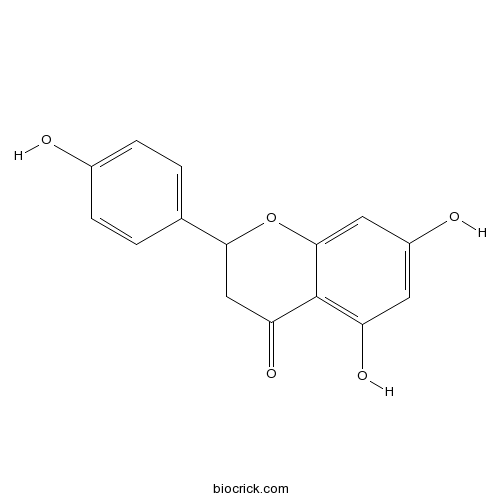Maclura cochinchinensis
Maclura cochinchinensis
1. The products in our compound library are selected from thousands of unique natural products; 2. It has the characteristics of diverse structure, diverse sources and wide coverage of activities; 3. Provide information on the activity of products from major journals, patents and research reports around the world, providing theoretical direction and research basis for further research and screening; 4. Free combination according to the type, source, target and disease of natural product; 5. The compound powder is placed in a covered tube and then discharged into a 10 x 10 cryostat; 6. Transport in ice pack or dry ice pack. Please store it at -20 °C as soon as possible after receiving the product, and use it as soon as possible after opening.
Natural products/compounds from Maclura cochinchinensis
- Cat.No. Product Name CAS Number COA
-
BCN5499
Genistein446-72-0
Instructions

-
BCN9061
(±)-Naringenin67604-48-2
Instructions

Two new prenylated isoflavones from Maclura cochinchinensis collected in Hoa Binh province Vietnam.[Pubmed: 29468891]
None
Gerontoxanthone B from Maclura cochinchinensis var. gerontogea exhibits anti-inflammatory potential as an aryl hydrocarbon receptor agonist.[Pubmed: 28662965]
The aryl hydrocarbon receptor (AhR) is a ligand-dependent transcriptional factor belonging to the basic helix-loop-helix-Per-Ahr/Arnt-Sim family. In this study, we evaluated the AhR agonistic activities of 12 xanthones isolated from the roots of M. cochinchinensis var. gerontogea using HepG2 cells transfected with pX4TK-Luc reporter plasmids. Gerontoxanthone B (GXB) showed the most potent activity at a concentration of 10μM, and the activity was inhibited by AhR antagonists such as GNF-351. GXB also increased cytochrome P450 1A1 mRNA and protein levels in HepG2 cells. Similar to the AhR agonist 2,3,7,8-tetrachlorodibenzo-p-dioxin, however, GXB suppressed the IL-1β-induced mRNA level of SAA1, an acute-phase response gene that is up-regulated AhR-dependently but XRE-independently. Thus, GXB shows XRE-dependent transcriptional activity and XRE-independent activity involving AhR.
Determination of Morin in Maclura cochinchinensis Heartwood by HPLC.[Pubmed: 27974355]
The HPLC-DAD method was developed to determine morin content in Maclura cochinchinensis Corner heartwood extract. The chromatographic separation was performed using a Hypersil BDS C18 column, isocratic solvent system of 0.5% acetic acid in water:acetonitrile (80:20) with 1.0 mL/min flow rate and detected at 355 nm. The standard curve of morin was linear in the range of 7-905 μg/mL. The method was precise with intra-day relative standard deviation (RSD) of lower than 1% and 2.06% for inter-day RSD. The method accuracy represented by percent recover was 99.58%. The highly efficient HPLC system developed from this study could detect morin contents in M. cochinchinensis heartwood samples collected from various locations in Thailand in the range of 0.74-1.57% w/w. This developed method provided a useful standardization procedure of M. cochincihinesis materials for further application in pharmacy and other commercial developments.
Xanthones from the roots of Maclura cochinchinensis var. gerontogea and their retinoic acid receptor-α agonistic activity.[Pubmed: 25838141]
A new xanthone (1) and a new naturally occurring xanthone (2) were isolated from the roots of Maclura cochinchinensis (Lour.) Corner var. gerontogea (Sieb. et Zucc.) Ohashi together with 10 known xanthones (3-12). Their structures were established by spectroscopic analyses including 1D and 2D NMR. Their retinoic acid receptor-α agonistic activity was evaluated using a luciferase reporter assay. Compound 2, gerontoxanthone A (3), gerontoxanthone B (4), and cudraxanthone I (11) showed moderate concentration-dependent activity. Furthermore, these four xanthones synergistically increased transcriptional activity in this assay in the presence of bexarotene, an RXR agonist.
Anti-herpes simplex virus component isolated from Maclura cochinchinensis.[Pubmed: 10715844]
The powerful anti-herpes simplex virus (HSV) activity of Maclura cochinchinensis in vitro prompted us to carry out biologically-guided separation of the active component(s). Ethyl acetate and methanol extracts exhibited anti-HSV-2 activity at EC50 values of 38.5 micrograms/ml and 50.8 micrograms/ml, respectively. Although petroleum ether extract was inactive, a chloroform extract was too toxic to the test cell culture to perform the test. Biologically-guided chromatographic separation of the ethyl acetate extract yielded compound A, identified as morin using a spectroscopic method. Morin exhibited anti-HSV-2 activity at an EC50 value of 53.5 micrograms/ml. Morin pentaacetate was synthetized, but was inactive. This result suggested that free hydroxyl groups are required for anti-HSV-activity, as demonstrated previously for the antiviral activity of other flavonoids.
Anti-herpes simplex virus activities of crude water extracts of Thai medicinal plants.[Pubmed: 10715843]
A number of Thai medicinal plants, recommended as remedies for herpesvirus infection and have been used in primary health care were investigated for their intracellular activities against herpes simplex viruses (HSV). Centella asiatica L., Maclura cochinchinensis Cornor, and Mangifera indica L. contained both anti-HSV-1 and -2 activities, as determined by plaque inhibition assay. An inhibition of the production of infectious HSV-2 virions from infected Vero cells could also be demonstrated. Combinations of each of these reconstituted extracts with 9-(2-hydroxyethoxymethyl) guanosine (acyclovir; ACV) resulted either in subadditive, additive, or synergistic interaction, against HSV-2, depending on the dose of ACV used; mixture of C. asiatica and M. indica exerted an additive effect in a similar assay. Furthermore, the inhibitory effects of these plant extracts were also substantiated by flow cytometric analysis of virus-specific antigens in the infected cells. The active constituent present in C. asiatica extract was determined to be asiaticoside while in M. indica was mangiferin. Thus, these data suggest therapeutic potential of these plant extracts.
Indonesian medicinal plants. XXI. Inhibitors of Na+/H+ exchanger from the bark of Erythrina variegata and the roots of Maclura cochinchinensis.[Pubmed: 9353889]
Through bioassay-guided separation of the methanol extracts of Indonesian medicinal plants, three inhibitors of the Na+/H+ exchange system, erythrinin B (2), euchrenone b10 (3), and 1,3,5-trihydroxy-4-(3-methylbut-2-enyl)xanthen-9-one (4), were isolated from the bark of Erythrina variegata (Fabaceae) (for 2) and the roots of Maclura cochinchinensis (Moraceae) (for 2, 3, 4). Compounds 2, 3, and 4 significantly inhibited the Na+/H+ exchange system of arterial smooth muscle cells, with minimum inhibitory concentrations of 1.25, 1.25, and 10 micrograms/ml, respectively. Three new prenylated xanthones named isocudraniaxanthones B (5) and A (7) and isoalvaxanthone (9) were also isolated from M. cochinchinensis and the chemical structures were elucidated on the bases of their chemical and physicochemical properties.


